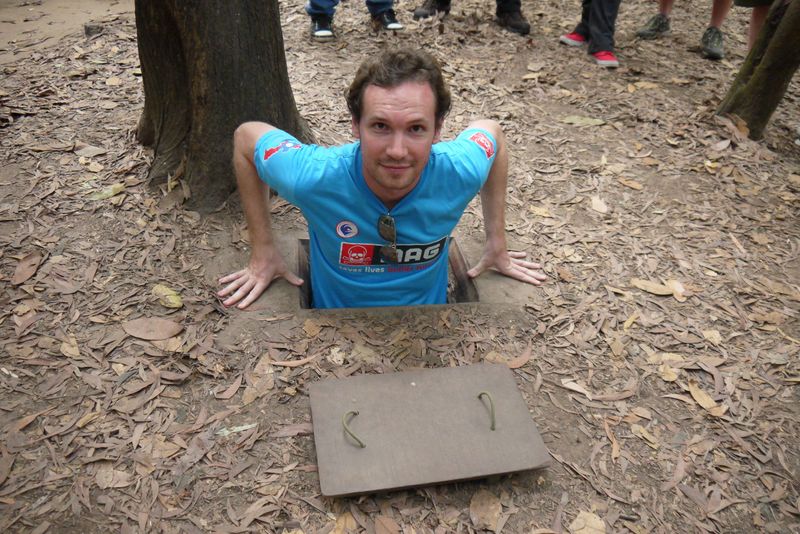
20 Apr Learning About The Vietnam War: Truth and Lies
I challenge anyone to visit Vietnam, or even just hear the country’s name, without thinking of the war America waged there mere decades ago. Coming from a western country, much of what I knew about the Vietnam War before visiting Asia was derived from popular media and what I was taught in history classes at school, which turned out to be very little. What I learnt from our month in Vietnam was that the truth about the war – if there even is such a thing – is far more complex than I ever imagined.
If you’re heading to Vietnam then you’ll probably need an invitation letter for your Visa On Arrival, we recommend Vietnam Visa as they provide a professional, efficient and transparent service.
I want to start this post by asserting that I am by no means an expert on Vietnamese history or the war; the opinions and observations I’m about to make are based upon the limited reading I’ve done on the subject and information from the museums I visited in Vietnam.

The Vietnam Flag in Halong Bay
Vietnam’s Hero – Ho Chi Minh
There was no escaping Vietnam’s deceased leader, Ho Chi Minh, as we travelled through the country; not only does he have a city named after him and museums dedicated to his life but his actual body lies embalmed and frozen forever in time at the mausoleum in central Hanoi. It’s hard not to feel that there’s undisputed love for Ho Chi Minh throughout Vietnam, particularly in the north of the country.
We even found ourselves falling a bit in love with Uncle Ho during our time in Hanoi after reading so much about his selfless aims for the country; how he farmed in his spare time and shared everything he had with the poor, how he sent letters to the US extending the arm of peace and how he ordered American war prisoners to be treated with respect. Yes, we became somewhat naively brainwashed into believing the revered, somewhat mythical version of Ho Chi Minh.
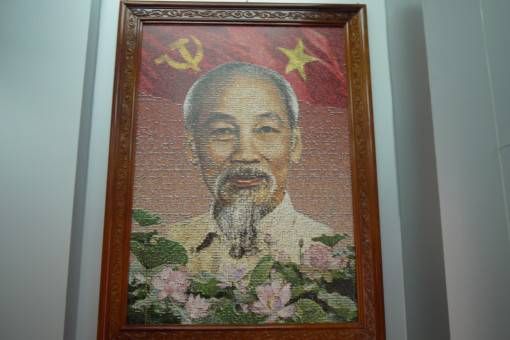
Ho Chi Minh
Dig a little deeper and you start to realise that there’s a lot of propaganda going around in Vietnam. The misleading displays that show American prisoners treated like royalty at Ho Lao prison in Hanoi, for instance, are undermined by first-hand accounts of torture and mistreatment. Seen in another light Ho Chi Minh can appear to be a callous and blood-thirsty leader; devising military strategies such as the Tet Offensive which killed thousands of Vietnamese and refusing to back-down in peace talks or release prisoners of war after the conflict was officially over. Did he liberate southern Vietnam, or take it over?
There are so many truths and lies involved in war; history is subjective and varies depending on who is telling the story – as evidenced by the one-sided views we heard about the ‘American Imperialist War’ and the ‘South’s Puppet Government’ while we were in Vietnam. The only thing we can be sure of is that there are no winners in war and the whole, pointless mess in Vietnam (and I think we pretty much all agree that the war was a complete waste of life), just proves that.
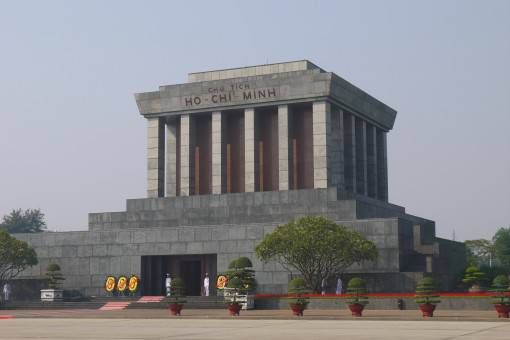
The Ho Chi Minh Mausoleum
However, by the time we left Vietnam Andrew and I still felt stung with injustice on behalf of the Vietnamese people for the atrocities that occurred there during the war.
Learning about the Vietnam War
It’s hard not to feel angry with American forces when you visit the War Remnants Museum in Ho Chi Minh City. I’d read that visiting was a harrowing experience and the museum certainly lived up to its reputation. The first floor was dedicated to documenting world-wide anti-war support for Vietnam, displaying hundreds of photos of protests, letters of support from country leaders and images of people who’d self-immolated to demonstrate against American involvement in Vietnam.
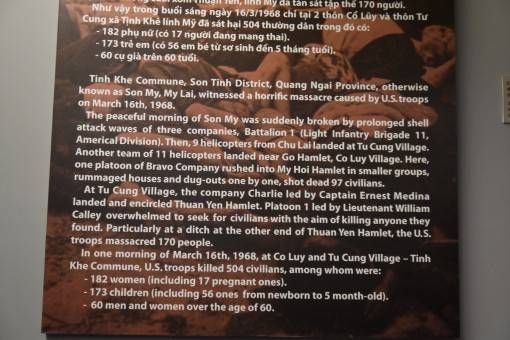
Museum information about the My Lai Massacre
This was striking enough, but it was the second floor and the sections about war atrocities and the use of chemical weapons in Vietnam that really shook us to the core. In hideous detail we learned about the merciless bombing campaigns and mass killings perpetrated by American forces in Vietnam. It’s estimated that around three million Vietnamese, including two million civilians, were killed in the war and a further two million were injured and 300,000 reported missing.
We saw haunting images and stories that stung your eyes to read and absolutely defied belief. Particularly disturbing was the famous story of the My Lai Massacre, where American soldiers wiped out almost an entire village, killing 170 innocent people including women and babies – they even disembowelled children. I was blinking tears from my eyes looking at a photo of two dead boys gunned down by American soldiers; one brother lay atop the other in an attempt to protect him.
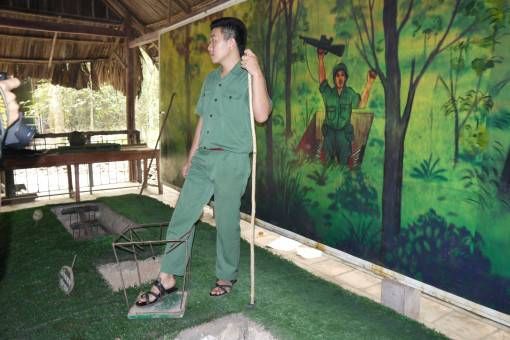
Vietnamese traps used in the war
Against war conventions, from 1961 to 1971 the US air force sprayed 72 million litres of toxic chemicals in Vietnam, polluting earth and water supplies and poisoning people. One of those evil weapons named Agent Orange contained Dioxin, the most harmful chemical ever discovered – just 85g of the substance can kill around eight million people. All in all, 4.8 million Vietnamese people were exposed to Agent Orange, resulting in cancer and severe birth defects which are passed through genes for generations to come. Unbelievably, while American veterans affected by Agent Orange have been compensated by the Government, the same cannot be said for Vietnamese victims.
I’m aware that many people feel the War Remnants Museum is full of propaganda and it’s true that atrocities perpetrated by the Viet Cong throughout the war aren’t mentioned at all. Yes, American soldiers must have been messed up and psychologically damaged to commit those acts and I’m sure they were conditioned by the army to view the Vietnamese people as less than human. I also know that many US soldiers came from the poorest sections of society and were fighting a war they didn’t necessarily agree with.
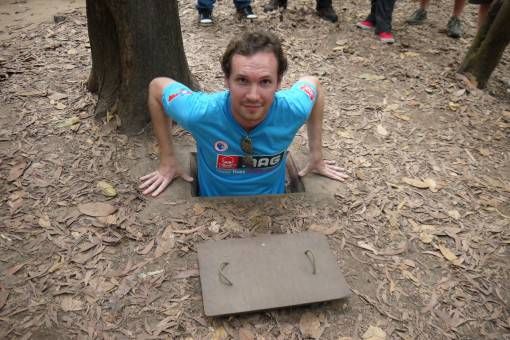
Testing out the entrance to the original Cu Chi tunnels
Despite all this, Andrew and I couldn’t help but think what the American Government did in Vietnam was just plain wrong. Even worse, you can see the same mistakes repeated again today in Iraq and Afghanistan. I’m shamefully aware that Britain is also involved in these battles and continues to wage unjust wars around the world.
Do we humans learn nothing?
Our Cu Chi Tunnels Tour
The last piece of war history we experienced in Vietnam was a trip to the Cu Chi Tunnels, located about an hour outside of Ho Chi Minh City. On arriving in the former forest village, we were shown a propaganda film about how the Cu Chi people lived and fought American forces in tiny underground tunnels throughout the war. In the film, American forces were described as a ‘Batch of Crazy Devils’ and the brutal slaying of US soldiers was celebrated.
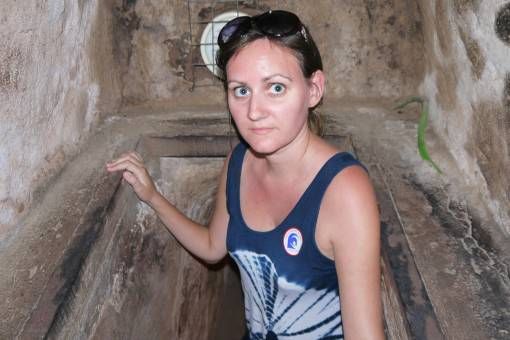
Descending into the claustrophobic tunnels
The Vietnamese fighters were notoriously ruthless and used deadly traps such as pits with spikes in them to defeat their enemy. We were able to view some of these traps and see the original tiny entrances to the tunnels, which Andrew only just fit in. Fighting in the narrow tunnels was hell for American soldiers, who were often maimed or killed by ingeniously gruesome traps. The Vietnamese navigated the tunnels with ease and often raided American camps, stealing US clothes and soap to confuse sniffer dogs.
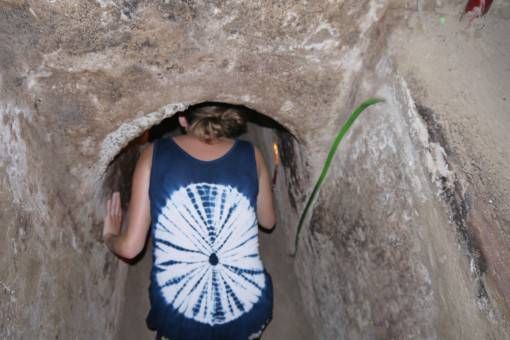
Crawling through the tiny tunnels
I found all the glorified talk of death and fighting pretty sickening and refused to go anywhere near the distasteful shooting range set up to generate some extra cash from tourists. The final part of the tour gave us a chance to crawl through replica tunnels; although they were enlarged to accommodate westerners I still found them incredibly tiny. Descending into the hot darkness I felt panicky and claustrophobic and crouched my way through the tunnels and back out above ground as quickly as possible, glad to put an end to learning about the atrocities of the Vietnam War.





James Long
Posted at 15:12h, 20 AprilHi Amy,
Great perspective on the post. Still vividly remember visiting both the tunnels and the museums when we were last in Vietnam. Certainly an eye opener compared to what we were taught and led to believe in the west. Did you manage to go into the actual tunnels they used. When we were there it was next to the larger tourist one. Knowing it didn’t have any animals in it was better but it was still only crawling room including the drops you had to do face first.
Cheers James
Amy
Posted at 12:53h, 23 AprilHi James, no, we weren’t allowed in the original tunnels, the most we could do was lower ourselves into the opening (which Andrew is doing in the picture above). Sounds like a pretty hairy experience though, especially the descending head first business!
Kellie
Posted at 17:26h, 20 AprilAs hard as hearing about the horrible things that happening during the war and the even harder job of trying to figure out what is true, I think when you go to a country finding out about the history is part of it.
Those tunnels look tiny. I’m the height of a 12 year old but I don’t think I’d have been able to go down there.
Amy
Posted at 12:51h, 23 AprilHi Kellie, there were ridiculously tiny! I agree that finding out about the history of places when you travel is so important, even when the history is pretty horrific.
Carmel
Posted at 12:16h, 22 AprilWe’ll write more about this later once we get to the motorbike tour we went on, but we went to the Vinh Moc tunnels in central Vietnam and although bigger, they are so extensive, I can’t imagine what it would have been like living down there for so long. We got all the way to the third level and it was hard not to panic a bit being 15 m underground.
We agree, obviously, it was a terrifying experience just imagining the atrocities. Also remember that a lot of the American soldiers that went over were very young and were fed a lot of propaganda about what they were going to be doing over there. Not to say that any of it was justified. Humanity lost in that war.
Amy
Posted at 12:45h, 23 AprilYour motorbike tour sounds really interesting Carmel, the tunnels there sound a lot less touristy than the ones we visited too. I got quite panicky after just a couple of minutes in those tunnels so I too cannot imagine how horrible it would be to have had to live in them. You’re totally right about the soldiers being fed propaganda too; there were so many losers in that war and no winners.
Victoria
Posted at 05:05h, 26 AprilThanks for the post Amy. Yeah, the issue of war is never amusing no matter which side one is on. I went on this museum and tunnel tour too. The museum, the film, and the pictures were not very pleasant and all I could think of was that most of the propaganda material, were from East Germany!
In my group, I was the only person who actually managed to get through that tunnel and I am petite. I can’t even imagine living down there for a single second. I’m normally OK in darkness but this was something else!
Amy
Posted at 11:42h, 26 AprilI can’t imagine living in the tunnels either Victoria, even for the much smaller Vietnamese people it must have been hell. You’re right, war definitely isn’t fun for anyone involved.